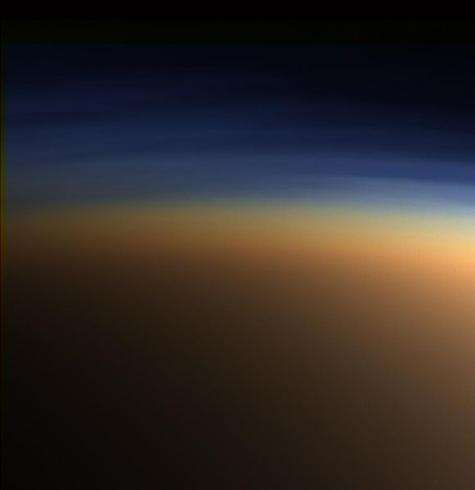May 9, 2011 report
Impact of comets could be responsible for Titan's atmosphere

(PhysOrg.com) -- Titan, Saturn's largest moon, may have had help with the creation of its nitrogen-rich atmosphere, according to a new study published in Nature Geoscience. Scientists believe that multiple impacts by comets hitting the ammonia ice on the moon’s surface converted the ammonia to nitrogen.
Where Titan’s nitrogen atmosphere came from has been a long standing question. Was it primordial or did it originate at a later time? In 2005, NASA launched the Huygens probe which ruled out primordial origin based on the low levels of argon-36, an isotope which should show higher levels in a primordial atmosphere.
Another theory was that sunlight could have contributed to the breakup of ammonia into nitrogen; however, this would have required Titan to have formed under high temperatures and differentiate into a rocky core and icy mantle layer. The probe however revealed that Titan was not completely differentiated.
New research, led by Yasuhito Sekine from the University of Tokyo, has found another possible explanation. Around four billion years ago Late Heavy Bombardment filled the solar system with large cosmic impacts. Sekine believes that during this period, Titan was hit numerous times causing the ammonia ice to convert into nitrogen.
With this theory in mind, Sekine set out to test it by using laser guns to fire bullets of gold, copper foil, and platinum at ammonia and ice targets. Propelled by high speed, the bullets hit the targets and the scientists found that this impact was enough to easily convert the ammonia into nitrogen.
Sekine calculated that in order to produce the amounts of nitrogen currently seen on Titan there would have had to have been at least 300 million billion metric tons of impactors which would have been possible during the Late Heavy Bombardment period.
More information: Replacement and late formation of atmospheric N2 on undifferentiated Titan by impacts, Nature Geoscience (2011) doi:10.1038/ngeo1147
Abstract
Saturn’s moon Titan has attracted much attention because of its massive nitrogen atmosphere, but the origin of this atmosphere is largely unknown. Massive secondary atmospheres on planets and satellites usually form only after a substantial differentiation of the body’s interior and chemical reactions during accretion, yet Titan’s interior has been found to be incompletely differentiated8. Here we propose that Titan’s nitrogen atmosphere formed after accretion, by the conversion from ammonia that was already present on Titan during the period of late heavy bombardment about four billion years ago. Our laser-gun experiments show that ammonia ice converts to N2 very efficiently during impacts. Numerical calculations based on our experimental results indicate that Titan would acquire sufficient N2 to sustain the current atmosphere and that most of the atmosphere present before the late heavy bombardment would have been replaced by impact-induced N2. Our scenario is capable of generating a N2-rich atmosphere with little primordial Ar on undifferentiated Titan. If this mechanism generated Titan’s atmosphere, its N2 was derived from a source in the solar nebula different from that for Earth, and the origins of N2 on Titan and Triton may be fundamentally different from the origin of N2 on Pluto.
© 2010 PhysOrg.com



















